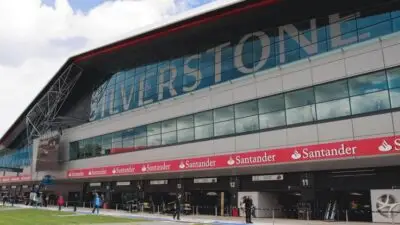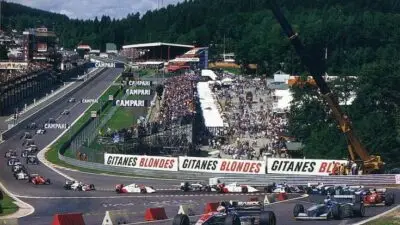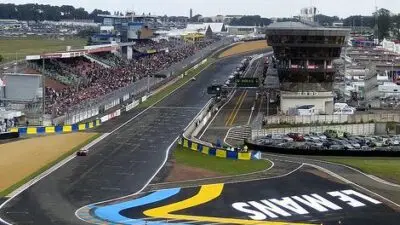The Monza Circuit stands as one of racing’s most hallowed grounds. Built in 1922 near Milan, Italy, this historic track is the third oldest purpose-built racing circuit in the world and has hosted Formula One’s Italian Grand Prix for over 70 years. With cars reaching speeds up to 230 mph on its long straights and drivers spending 80% of each lap at full throttle, Monza has rightfully earned its nickname as the “Temple of Speed.”
The 5.793 km (3.6 mile) track combines high-speed straights with iconic corners like the Curva Grande and Parabolica, creating a unique challenge that tests both machine and driver. This combination makes Monza the highest average speed circuit in the Formula One calendar at 264 km/h (164 mph). Set within the picturesque Royal Villa of Monza park, the circuit blends breathtaking speed with natural beauty, creating an atmosphere unlike any other racing venue.
Key Takeaways
- Monza Circuit is the fastest track in Formula 1 with an average speed of 264 km/h and cars reaching 230 mph on its straights.
- Built in 1922, this historic 5.793 km track has hosted the Italian Grand Prix for over 70 years, making it a cornerstone of motorsport heritage.
- The circuit’s combination of long straights and challenging corners creates unique driving dynamics where drivers spend 80% of each lap at full throttle.
The Fast and Fearsome Identity of Monza Circuit
Monza stands as one of motorsport’s most iconic venues, defined by its breathtaking speed and rich heritage that dates back to 1922. The circuit combines straight-line velocity with challenging corners that have tested the greatest drivers in history.
Why Monza Is Known as the Temple of Speed
Monza earned its nickname “Temple of Speed” through its reputation for producing some of the fastest racing in motorsport. The Autodromo Nazionale Monza features long straights where Formula 1 cars reach incredible velocities, often exceeding 350 km/h (217 mph). This speed-centric design has remained central to the circuit’s identity since its inception.
The track’s layout emphasizes pure speed with an overall average pace of 158 kph (98 mph), making it one of the fastest circuits in the Formula 1 calendar. Drivers spend over 75% of the lap at full throttle, creating a unique challenge that favors powerful engines and efficient aerodynamics.
The roaring engines echoing through the parkland setting have become as much a part of Monza’s character as its architectural grandeur.
What Sets the Monza Circuit Apart
Monza’s distinctive character comes from its perfect blend of heritage and speed. The 5.793-kilometer track features a combination of:
- Long, high-speed straights (Rettifilo and Rettilineo)
- Legendary corners (Parabolica, now Alboreto curve)
- Challenging chicanes added for safety
- Historic banked sections (now abandoned but still visible)
Originally built in 1922, Monza has evolved while maintaining its essence. After a 1933 tragedy, developers created alternative layouts to balance speed with safety. The current design mixes fast straights, sweeping corners and tight chicanes, producing dramatic racing.
Set within a picturesque Italian royal park, Monza’s natural setting adds to its appeal, creating a unique atmosphere that distinguishes it from modern, purpose-built facilities.
Monza in the World of Formula One
The Italian Grand Prix at Monza has been a cornerstone of Formula 1 since the championship’s inception in 1950. As home to Ferrari’s passionate fans—the Tifosi—the atmosphere is electric, with a sea of red filling the grandstands.
Monza has witnessed countless historic moments in F1, from Juan Manuel Fangio’s dominance to Lewis Hamilton’s speed records. The circuit rewards bold driving and perfect car setup, with teams developing special low-downforce packages specifically for this track.
The high speeds and heavy braking zones create overtaking opportunities, particularly into the first chicane. This combination makes Monza not just about pure speed, but also about strategic brilliance and technical excellence.
Monza completes the European leg of the Formula 1 season, giving it a special place in the championship calendar and in racing culture worldwide.
Key Features and Layout of the Monza Circuit
The Monza Circuit, known as the Temple of Speed, features a distinctive layout focused on high-speed sections with challenging technical areas. Built in 1922, this historic 5.793 km track remains one of Formula 1’s fastest and most iconic venues.
High-Speed Straights and Corners
Monza’s layout prioritizes raw speed with its famous long straightaways where cars reach exceptional velocities. The main straight (starting straight) allows drivers to push their engines to the limit before entering the first chicane.
After navigating the first chicane, drivers encounter the Curva Grande, a high-speed right-hander that tests courage and aerodynamic efficiency. This sweeping corner requires precise steering inputs while maintaining momentum.
The track features multiple straights that showcase straight-line speed capabilities of modern race cars. These sections create thrilling overtaking opportunities and highlight power unit performance differences between competitors.
Teams must find the optimal low-downforce aerodynamic setup to maximize straight-line speed without compromising stability in corners – a delicate balance that defines success at Monza.
Notable Chicanes and Turns
The Variante del Rettifilo (first chicane) serves as a critical braking point after the main straight. Drivers must slow from over 350 km/h to under 80 km/h in seconds, making it one of F1’s most demanding corners and a common site for first-lap incidents.
The Lesmo curves (Lesmo 1 and Lesmo 2) challenge drivers with their technical nature. These medium-speed right-handers require precise racing lines and careful throttle application to maintain momentum for the following straight.
Variante Ascari, a fast left-right-left sequence, demands complete driver commitment. Mistakes here severely impact lap times as it leads to the final straight.
The Parabolica (recently renamed Curva Alboreto) provides a dramatic finale to each lap. This long right-hander tests driver skill as they gradually apply throttle while managing increasing lateral forces.
Technical Demands and Braking Zones
Monza features some of Formula 1’s most extreme braking zones. The approach to the first chicane requires deceleration from approximately 350 km/h to 70 km/h in just 150 meters.
Brake cooling becomes critically important due to the intense thermal loads generated by repeated heavy braking events. Teams must carefully manage brake temperatures throughout the race to prevent failure.
The circuit’s low-downforce requirements create a challenging setup dilemma:
- Straight-line speed: Critical for overtaking
- Braking stability: Essential for chicanes
- Corner exit traction: Needed for acceleration phases
Engine power and efficiency play outsized roles at Monza compared to most other circuits. The long full-throttle sections expose any power unit weaknesses and reward strong mechanical grip on corner exits.
Monza’s Unique Architectural Elements
The circuit is nestled within the historic Royal Park of Monza, creating a distinctive atmosphere with ancient trees lining much of the track. This natural setting adds character while presenting safety considerations.
Monza’s famous banking, though no longer used in modern races, remains an iconic architectural element. This steeply banked oval section stands as a monument to early motorsport engineering and the circuit’s rich history.
The podium at Monza offers one of Formula 1’s most memorable celebrations. Located above the starting straight with the passionate Tifosi (Ferrari fans) gathered below, it provides an electric atmosphere for race winners.
The pit complex and paddock facilities have been modernized while preserving the circuit’s historic character. These upgrades ensure Monza meets contemporary safety standards while honoring its status as one of motorsport’s most revered venues.
Monza Circuit in Formula One Racing
The Monza Circuit stands as a cornerstone in Formula One history, hosting the Italian Grand Prix for over 70 years. This legendary track combines blazing speeds, passionate fans, and historic moments that have defined motorsport excellence.
The Italian Grand Prix at Monza
The Italian Grand Prix at Monza is one of Formula One’s oldest and most prestigious races. Built in 1922, Monza became the world’s third purpose-built race track after Brooklands and Indianapolis.
The circuit has maintained its place on the F1 calendar since the championship began in 1950, missing only the 1980 season. Often scheduled in early September, the Italian Grand Prix at Monza traditionally marks the conclusion of the European leg of the Formula 1 season.
Fans call Monza the “Temple of Speed” for good reason. With average speeds around 250-260 km/h, it remains the fastest track in Formula 1, challenging both drivers and machinery to their limits.
Lap Records and Milestones
Monza’s high-speed nature has produced some of F1’s most impressive lap records. The current official race lap record belongs to Rubens Barrichello, who set a blistering time while driving for Ferrari.
The track’s layout has changed several times throughout its history, but it has maintained its character as a speed-focused circuit. Today’s 5.793 km layout features 11 corners, with many being high-speed sweeping turns like Curva Grande and Parabolica.
Some notable milestones at Monza include:
- Fastest qualifying lap: Lewis Hamilton (Mercedes)
- Most wins: Lewis Hamilton and Michael Schumacher (5 each)
- Most constructors’ wins: Ferrari (19)
The circuit has witnessed numerous historic moments, including the closest finish in F1 history and several championship-deciding races.
Famous Drivers and Iconic Performances
Ayrton Senna‘s dominance at Monza in the late 1980s and early 1990s remains legendary. His precise driving style perfectly suited the high-speed demands of the circuit, particularly while driving for McLaren.
Lewis Hamilton has established himself as a modern Monza master. His five victories demonstrate his exceptional skill at maximizing straight-line speed while managing the challenging braking zones that define the circuit.
Other memorable performances include:
- Juan Manuel Fangio’s victory in the 1950s
- Stirling Moss’s incredible drive in 1956
- Sebastian Vettel’s emotional win for Ferrari in 2019
The passionate Italian fans, known as the “tifosi,” create an electric atmosphere, especially when Ferrari performs well. Their sea of red in the grandstands forms an iconic backdrop to the racing action, making Monza victories particularly special for drivers of all nationalities.
Driving Dynamics: Strategy and Vehicle Setup
Success at Monza demands specific driving techniques and car setups that differ from most Formula 1 circuits. The high-speed nature of this track creates unique challenges that drivers must overcome through precise vehicle configuration and tactical driving.
Optimizing for Straight-Line Speed
At Monza, straight-line speed is paramount due to the circuit’s long acceleration zones. Teams typically run the lowest downforce configuration of the season, with minimal wing angles to reduce drag on straights.
The car setup requires a delicate balance. Reducing downforce increases top speed but compromises stability in corners. Engineers often opt for:
- Wing settings: 1-3 for front and rear wings
- Suspension: Softer to maintain grip in high-speed sections
- Gear ratios: Longer than usual to maximize top-end speed
Fuel management becomes critical as the low-downforce setup increases consumption. Drivers must perfect the art of coasting before braking zones to save fuel without sacrificing lap time.
Mastering Slipstreaming and Overtaking
Slipstreaming is exceptionally powerful at Monza and forms the backbone of race strategy. The aerodynamic advantage gained by following another car can provide up to 10-15 km/h additional speed on long straights.
Drivers position themselves roughly 0.8-1.2 seconds behind competitors entering straights to reduce drag. This technique creates prime overtaking opportunities before heavy braking zones at chicanes.
Key overtaking spots include:
- End of the main straight into Turn 1 (Rettifilo)
- Approaching the Ascari chicane
- The run into Parabolica (now Alboreto)
Patience is crucial. Rushing an overtake can lead to locked brakes and missed chicanes, resulting in time penalties that negate any gained positions.
Braking and Cornering Techniques
Monza’s chicanes demand exceptional braking precision after extended high-speed sections. Drivers must transition from speeds exceeding 350 km/h to under 80 km/h in seconds.
Brake temperatures pose a significant challenge. The long straights cause cooling, followed by intense heat generation during hard braking. This can create conditions similar to driving on ice when drivers first apply pressure.
Effective techniques include:
- Progressive braking: Initial gentle application followed by increasing pressure
- Trail braking: Continuing light brake pressure while turning in
- Curb usage: Strategically riding curbs at chicanes to straighten the line
Carrying momentum through Parabolica and Curva Grande is essential for lap time. Drivers gradually apply throttle through these sweeping corners, avoiding sudden inputs that could destabilize the car at high speed.
Experiencing Monza Circuit Beyond Racing
The Monza Circuit offers visitors amazing experiences that go beyond watching race day events. Fans can explore the legendary “Temple of Speed” through guided tours and enjoy the beautiful surrounding parkland with its historical attractions.
Track Tours and Visitor Opportunities
The Monza Circuit Experience provides an unmissable opportunity for everyone to discover this iconic motorsport venue. These guided tours take visitors behind the scenes of the Autodromo Nazionale Monza, revealing secrets and stories from its rich racing history.
The 80-minute Tour Experience includes access to normally restricted areas. Visitors can explore the hospitality rooms, press room, race direction, and stand on the famous podium where champions celebrate.
Tours operate on board cars and minivans, making them accessible for all ages. The experience resumed in March 2025, allowing motorsport enthusiasts to visit even on non-race days.
Monza Park and Local Attractions
The Monza Circuit sits within one of Europe’s largest walled parks, offering more than just racing excitement. Visitors can rent bicycles to explore the most scenic areas of Monza Park, combining motorsport with natural beauty.
Beyond the track, Monza boasts impressive cultural sites. The city features royal residences and historical landmarks that tell stories spanning centuries.
Visitors can create a perfect day trip by combining a morning circuit tour with afternoon exploration of Monza’s cultural treasures. The park’s extensive grounds provide peaceful walking paths, picnic areas, and historical monuments.
The area surrounding the circuit offers a blend of motorsport heritage and Italian cultural richness that appeals to racing fans and casual tourists alike.
The Enduring Legacy of the Monza Circuit
The Monza Circuit has cemented its place in motorsport history through decades of thrilling races and iconic moments. Its unique combination of high speeds, passionate fans, and rich heritage continues to make it one of Formula 1’s most treasured venues.
Record-Breaking Moments and Historical Impact
The Autodromo Nazionale Monza, built in 1922, holds the distinction of being the third purpose-built racing circuit in the world and the oldest in mainland Europe. Its layout has produced some of Formula 1’s fastest races and most memorable moments.
As the Temple of Speed, Monza has witnessed numerous speed records throughout its history. The circuit’s long straights and high-speed sections regularly produce average lap speeds exceeding 250 km/h.
The track has hosted the Italian Grand Prix almost continuously since 1950, missing only one year in Formula 1’s modern era. This consistency has allowed it to become the venue for many pivotal championship moments.
Legendary drivers like Juan Manuel Fangio, Jim Clark, and Michael Schumacher have all crafted their legacies on Monza’s asphalt, contributing to the circuit’s storied history.
Monza’s Status in Motorsport Culture
The passionate Italian fans, known as the Tifosi, are integral to Monza’s unique atmosphere. Their fervent support, particularly for Ferrari, creates an unmatched energy that drivers and teams cite as truly special.
Former F1 champions Jackie Stewart and David Coulthard have highlighted Monza’s significance, describing it as an integral part of Formula 1’s identity. The circuit represents speed, tradition, and the purest form of racing.
The track’s setting within the Royal Park of Monza adds to its charm, blending natural beauty with motorsport excellence. This juxtaposition has helped maintain its appeal through changing eras.
Monza remains a true test of both machine and driver, demanding courage through high-speed corners like Parabolica while requiring perfect technical execution. This balance ensures its continued relevance in modern Formula 1.










